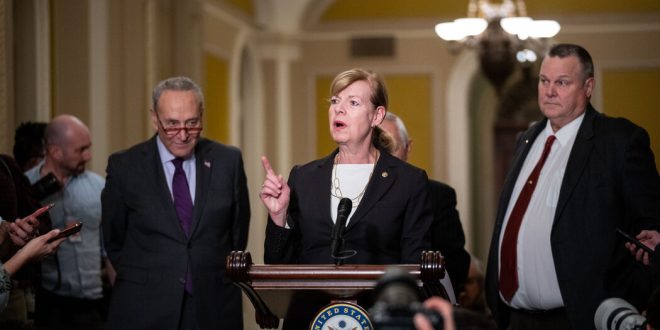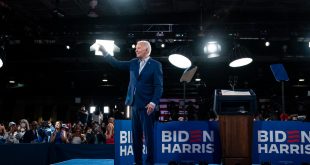Democratic candidates for the Senate in Arizona, Nevada, Pennsylvania and Wisconsin lead their Republican rivals and are running well ahead of President Biden in key states where he continues to struggle, according to polls by The New York Times, The Philadelphia Inquirer and Siena College.
The battleground surveys of registered voters indicate that the president’s difficulties against former President Donald J. Trump may not be enough to sink other Democrats, especially Senate incumbents who are facing less-well-known Republicans.
Ticket-splitters are not abundant — about 10 percent of Trump voters back the Democratic candidate for Senate in the four states, while about 5 percent of Biden supporters back the Republican.
But those voters are enough to give Democrats a chance at holding the Senate, where they currently hold a one-seat majority. To maintain control, the Democrats would have to sweep every competitive Senate seat and win the White House.
In Pennsylvania, Senator Bob Casey, a Democrat, has the support of 46 percent of voters, against the 41 percent who say they back his Republican challenger, the wealthy finance executive David McCormick, although Mr. Trump holds a slender advantage in a head-to-head race with Mr. Biden, 47 percent to 44 percent.
In Wisconsin, the Democratic incumbent, Senator Tammy Baldwin, holds a wider, 49-percent-to-40 percent lead over the Republican banker Eric Hovde. Mr. Biden is up slightly against Mr. Trump, 47 percent to 45 percent.
In Nevada, where Mr. Biden is struggling the most, Senator Jacky Rosen, a Democrat, narrowly leads her Republican challenger, Sam Brown, a wounded combat veteran, 40 percent to 38 percent, with 23 percent of registered voters undecided.
In Arizona, the one battleground state polled with an open Senate seat, Representative Ruben Gallego, a Phoenix-area Democrat, leads Kari Lake, the Republican former news anchor who is closely allied with Mr. Trump, 45 percent to 41 percent, with 14 percent undecided. Mr. Trump leads Mr. Biden in Arizona, 49 percent to 42 percent.
The contrasting results underscore the power of incumbency, and how it appears to be nullified in the case of a former president challenging a sitting president. Voter after voter expressed comfort with the sitting Senate Democrat, and an almost complete lack of knowledge about the Republican challengers.
“Jacky Rosen has been around a long time,” said Brian Dickinson, a 25-year-old registered Democrat in Las Vegas who said he was considering splitting his ticket and voting for Mr. Trump. “I think she’s a very good Democrat.”
In Pennsylvania, 23 percent of Republicans viewed Mr. Casey favorably, while only 6 percent had a favorable view of Mr. Biden.
Casey “is a name that I’ve heard,” said Harry Wirebach, a 56-year-old veteran and unaffiliated voter in Croydon, Pa. Mr. Casey was first elected to the Senate in 2006; his father, Bob Casey, was a two-term Pennsylvania governor.
But that Democratic advantage has not lifted Mr. Biden’s standing, and very few respondents lacked opinions about the leading candidates for president.
“I would vote for a roadkill opossum if that was a choice over those three,” Mr. Wirebach said of Mr. Biden, Mr. Trump and the independent candidate Robert F. Kennedy Jr.
Indeed, many ticket splitters said their presidential choices had left them angry and discontented.
“I’m not a party person. I am more for the state, and Gallego has done a good job for the state,” said Terry Crabtree, a disabled 52-year-old from Tonopah, Ariz., in Maricopa County, who operates a food truck, Carnivore Creations. “I can’t stand Biden. I think he ought to be in prison. I think Trump should be in prison as well. I hate being given those two choices.”
The slim Democratic advantages in Arizona, Nevada, Pennsylvania and Wisconsin still only give the party an outside chance of holding Senate control. With the retirement of Senator Joe Manchin III, a Democrat in deep-red West Virginia, Democrats would have to win every competitive Senate seat along with the White House to give Vice President Kamala Harris the tiebreaking vote next year. Even with a Democratic sweep of every other competitive Senate contest, a Trump victory and the loss of Mr. Manchin’s seat would give Republicans control of the chamber.
Another battleground state, Michigan, will also have a Senate contest to fill the seat of the retiring Democrat Debbie Stabenow, but because the Republican candidate won’t be settled until the August primary, the Times/Siena poll did not ask Michigan voters their preference.
Two other consequential Senate races are not in the presidential battleground states polled. Both Senators Jon Tester of Montana and Sherrod Brown of Ohio must win re-election this November in their heavily Republican-leaning states to give Democrats a chance to hold their majority.
Democratic Senate candidates are running stronger than Mr. Biden with key Democratic constituencies such as young voters, Black voters and Hispanic voters. Latino voters again appear to be crucial, at the presidential level and on the Senate ballot. Mr. Trump is winning 42 percent of the Hispanic vote in the battleground states, but Senate Republicans are at only 29 percent.
“I like what she’s basically doing,” Joseph Gonzalez, a 60-year-old Hispanic truck driver in Milwaukee, said of Ms. Baldwin, who is seeking a third term in the Senate. “I do not like what President Biden’s doing. He’s failing the United States.”
Democratic senators, flush with cash and spending heavily on the airwaves, are already distancing themselves from Mr. Biden. A new advertisement from Mr. Casey features hard-hatted workers declaring, “Our own government turned their backs on us” by using imported steel, without saying which administration had done so. It credits Mr. Casey for a “buy America” provision in the president’s sprawling infrastructure bill, a provision for which Mr. Biden also claims credit.
Not all ticket splitters sided with Mr. Trump and the Democratic Senate nominee.
Benjamin Johnsen, a 37-year-old truck driver from Superior, Wis., said he has supported Mr. Biden since he was Barack Obama’s vice president, trusting him to defend the country against terrorism. But he said he wants Republicans to control the Senate and keep taxes low, so he is leaning toward Mr. Hovde, the Republican challenging Ms. Baldwin.
But more typical was Chris Myers, a 52-year-old union construction worker in Hartford, Wis. Mr. Myers said he had never seen more construction work than what was underway now in the state. In fact, he said, he was helping to build the $3 billion Microsoft artificial intelligence data center that Mr. Biden was trumpeting on Wednesday in Wisconsin as a promise delivered by his administration.
Yet Mr. Myers said he would split his vote by supporting Ms. Baldwin, whom he praised for doing “some good things for the state,” and Mr. Trump, saying: “I like his go-get-’em, take-no-crap attitude.” Mainly, Mr. Myers complained that Mr. Biden’s visit last week celebrating the creation of Mr. Myers’s job ended up slowing down the concrete trucks.
In virtually every Senate contest, enough undecided voters could swing the races toward the Republican challengers. That is a marked contrast with the presidential race, where battleground voters say their views of Mr. Biden and Mr. Trump are more locked in.
“I am voting for Donald Trump, guaranteed,” said Wesley Scarbrough, a 22-year-old electrician in Las Vegas who is Hispanic. But, though he told a pollster he favored Ms. Rosen, he said in a follow-up interview that he was not sure. “Honestly, with the Senate,” he said, “I don’t really know.”
Asked why Hispanic voters in Nevada were breaking toward Mr. Trump, Mr. Scarbrough answered, “The border crisis has a lot to do with it.” He said that migrants crossing the border were “lazy, just looking for free things.”
Andrew Trunsky contributed reporting.
Here are the key things to know about how these polls were conducted:
-
We spoke with 4,097 registered voters in Arizona, Georgia, Michigan, Nevada, Pennsylvania and Wisconsin from April 28 to May 9, 2024.
-
Our polls are conducted by telephone, using live interviewers, in both English and Spanish. Nearly 95 percent of respondents were contacted on a cellphone for this poll. You can see the exact questions that were asked and the order in which they were asked here.
-
Voters are selected for the survey from a list of registered voters. The list contains information on the demographic characteristics of every registered voter, allowing us to make sure we reach the right number of voters of each party, race and region. For this set of polls, we placed nearly 500,000 calls to about 410,000 voters.
-
To further ensure that the results reflect the entire voting population, not just those willing to take a poll, we give more weight to respondents from demographic groups underrepresented among survey respondents, like people without a college degree. You can see more information about the characteristics of our respondents and the weighted sample on the methodology page, under “Composition of the Sample.”
-
When the states are joined together, the margin of sampling error among registered voters is plus or minus 1.8 percentage points. Each state poll has a margin of error ranging from plus or minus 3.6 points in Pennsylvania to plus or minus 4.6 points in Georgia. In theory, this means that the results should reflect the views of the overall population most of the time, though many other challenges create additional sources of error. When computing the difference between two values — such as a candidate’s lead in a race — the margin of error is twice as large.
You can see full results and a detailed methodology here. If you want to read more about how and why we conduct our polls, you can see answers to frequently asked questions and submit your own questions here.
The New York Times/Philadelphia Inquirer/Siena College poll of Pennsylvania was funded by a grant from The Lenfest Institute for Journalism. The poll was designed and conducted independently from the institute.
 Top Naija News – Nigeria News, Nigerian News & Top Stories Top Naija News – Nigerian Newspapers, Nigerian News. topnaijanews is a daily Nigerian newspaper covering Latest News, Breaking News, Entertainment, Sports, Lifestyle and Politics.
Top Naija News – Nigeria News, Nigerian News & Top Stories Top Naija News – Nigerian Newspapers, Nigerian News. topnaijanews is a daily Nigerian newspaper covering Latest News, Breaking News, Entertainment, Sports, Lifestyle and Politics.




